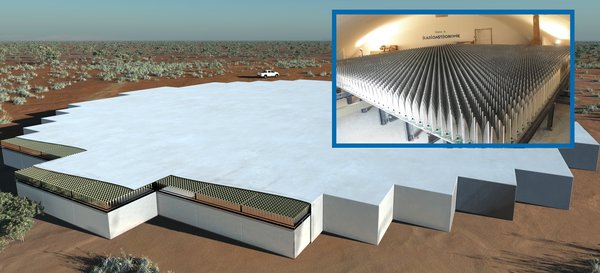- display options ▼
- normal
- full width
 |
Square Kilometre Array: Aperture Array Technology |  |

This artist’s conception drawing shows a single station of a midfrequency aperture array instrument proposed for the Square Kilometre Array (SKA). Over two hundred stations will be required for the full SKA. The inset picture at the top right is the currently operational EMBRACE array at the Nançay radio observatory in France.
Modern digital technology has sparked a revolution in radio astronomy techniques, resulting in a fundamental change in how telescopes are built and operated. Instead of large mechanical structures, aperture arrays can be built which are composed of many small antennas with signals combined together to form the equivalent of a telescope with large collecting area. The design philosophy puts the “hard work” on the digital electronics, while the mechanical parts, such as dishes and antennas, are made as simply as possible. The result is an instrument built from many small mechanical components and electronically combined together with the power of fast digital processors.
Not only is such a system easier to build and maintain, it also provides distinct operational advantages. Perhaps most importantly, aperture arrays have an extremely large field of view for fast surveys of the sky. Radio telescopes at frequencies below ∼300 MHz and lower have proven this philosophy with great success. These include LOFAR, the Low Frequency Array in Europe (van Haarlem et al., 2013), and the Murchison Widefield Array in Western Australia (Tingay et al., 2013), both considered Square Kilometre Array2 (SKA) pathfinder/precursor instruments.
The challenge to move this design philosophy to higher frequencies is mainly associated with the large number of components and associated electronics. At frequencies around 1 GHz, the goal is to fully sample the aperture with antennas that are closely spaced together. The result is an instrument which collects all the available signal, as would do a dish of the same size, but having all the advantages of an aperture array, including the possibility for full sky imaging. This technological development has been pursued for the past 20 years, initially with the pioneering work at ASTRON (van Ardenne, 2000), and then joined by partners during the SKA Design Studies (Torchinsky et al. (eds), 2009) leading to the fully operational prototype called EMBRACE (Kant et al., 2011, Torchinsky et al., 2016) with the equivalent collecting area of a 10 metre diameter dish, pictured in the inset of the figure above. Building on the results of EMBRACE, we are now in the process of defining a much larger demonstrator called MANTIS, the MidFrequency Aperture Array Transient and IntensityMapping System, that will showcase the immense potential of midfrequency aperture array technology for doing the lion’s share of transformational SKA science.